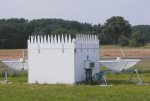Noise-Immune Analytical Methods for SODAR
| Working Group: | WG Industrial Mathematics |
| Leadership: | Prof. Dr. Dr. h.c. Peter Maaß ((0421) 218-63801, E-Mail: pmaass@math.uni-bremen.de ) |
| Processor: | Dr. Kamil Kazimierski |
| Project partner: | METEK GmbH, Elmshorn |
| Time period: | 01.10.2006 - 30.09.2008 |

In many areas of metrology, measured signals without complex signal processing can only be used for further analytical steps under certain circumstances. The same applies to the SODAR technique, where measured sound signals often become unusable as a result of ambient noise.
A SODAR (sound detection and ranging) is a meteorological measuring device which can create a vertical wind profile which reaches up to a height of several hundred metres from the ground. This is achieved by emitting sound impulses in several directions, a tiny fraction of which are back scattered at atmospheric density inhomogeneities. Important here is that the reflected waves are Doppler-shifted proportionally to the radial wind direction. With the help of at least three linearly independent directions it is thus possible to reconstruct the wind speed. The finite speed of sound means that signals from higher up are picked up later and hence a vertical wind profile can be compiled.
SODARs are required, for example, for monitoring the spread of industrial emissions, for environmental impact investigations, to estimate the energy yield of planned wind power sites or in atmospheric research. In practice, the potential interference of noise seriously limits the possible fields of application of SODARs because the conditions required for satisfactory operation (low ambient noise and no reflecting objects in the vicinity of the sound beam) cannot be met at many of the sites mentioned above - at least not without complex signal processing.
It is only in recent years that new possibilities have been discovered. First of all there was a problem with the data storage. In order to evaluate algorithms, data has to be collected in all possible weather situations and environmental conditions. Since the devices generate up to 7 gigabytes of data per day, however, it is not easy to store the data over a long period of time.
The second thing is that high computing capacity is required to apply complex algorithms to this amount of data. From experience gained by the CIM in the EU CRAFTProject MEPROS with similar data from so-called Radar Wind Profilers (RWP), one can conclude that the algorithms only just run in real time on a modern Desktop PC. This means that data from one day requires just under 24 hours of computation time. The evaluation of data from at least six months therefore involves considerable computing time.
The third thing is that the research into methods of cleaning up this type of data has made great progress recently. In the MEPROS project we were able to show that, for RWP, data time-frequency methods such as discrete Gabor or wavelet transformation are particularly suitable. For SODAR, the heterogeneity of noise sources makes it necessary to have a multiplicity of approaches; the methods developed in MEPROS appear to be only partially suitable. Little research has been carried out into time-frequency approaches for SODAR.

